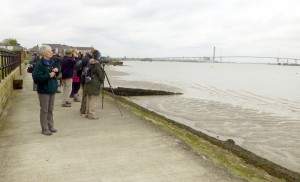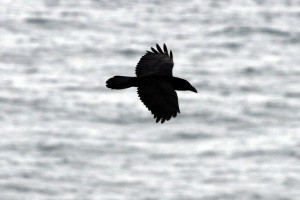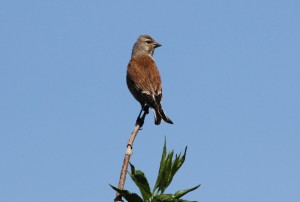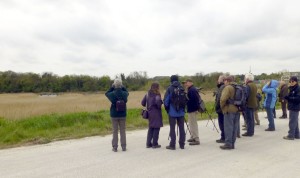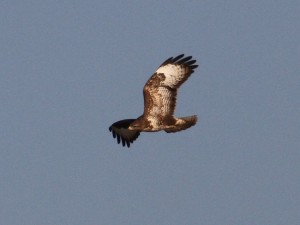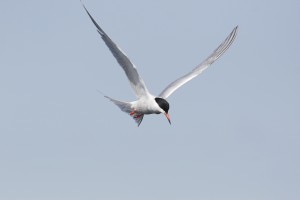RSPB Bexley Group, Field trip to Swanscombe Marshes.
Report by Ralph and Brenda Todd
Saturday 2nd May 2015.
Yet another dull, cool, windy morning but that didn’t deter 15 members joining Brenda and I and our relief guide Andy Lawson for the first ever visit to this site in the 36 year history of the group. About 20 minutes from central Bexley – what had we been missing?
This trip was planned to highlight local Thames side marshes that have for years been a great place for birds (and other wildlife) but is now under close scrutiny from Qatari developers for a proposed Paramount theme park (see http://www.bexleywildlife.org/swanscombe-marshes-threatened-by-theme-park-bulldozers/).
Our original guide having been offered a post with Birdlife Cyprus was unable to lead the walk. Andy proved a brilliant stand-in – a well-known Kent birdwatcher, local to Swanscombe so knows the area well and its birds and he is also a specialist in gull identification that many of us benefited from.
Even before we left the car park we had started our list with 8 species including sorting out the song/calls of blackcap, chaffinch and dunnock. We made our way through “old” Greenhithe to the riverside where immediately we saw 3 common terns, either flying or resting on a buoy. Within seconds we were also enjoying a fabulous fly by raven as it headed up river and over the Queen Elizabeth bridge (two more were seen later over the marsh).
An off shore barge provided shelter for oystercatcher, cormorant and lesser black-backed gulls. A whimbrel flew down river, landed on the shore close by and gave fantastic close views (when it wasn’t camouflaged amongst the rocks and seaweed). The riverside dwellings certainly have a great view of the river and we saw a few house martins prospecting nearby. Timed for migration we were encouraged to keeps eyes skyward and Phil Cliffe soon found the first goodie with a high flying marsh harrier – a pair were seen later on the walk.
It was clear the cool wind was keeping many small birds low and/or quiet but cetti’s, sedge and reed warbler were soon picked up as we overlooked the lovely freshwater reed bed – known I believe as Black Duck marsh. On the water, little grebe, tufted duck, gadwall, coot, moorhen and mute swan were seen with loads of black-headed gulls. Reed bunting, common whitethroat, stock dove, linnets and our first swallows plus a small heronry with young in nests around the edges.
For most of us our first swifts of the year swooped overhead and a couple of sand martins appeared with the house martins. Such was the abundance of birdlife and the interest in the area we made very slow progress, indeed, after 90 minutes walking we were nowhere near the desired destination – Broadness Salt Marsh and Botany Marsh – but we had a deadline which needed to be met so, having spent some time discussing the value of that bit of Swanscombe marsh we had seen (most of which is slated to be developed), we made our way back along the river wall.
Still new species were sighted – a distant peregrine, buzzard and sparrowhawk.
A cuckoo was heard but despite much searching not found but a common sandpiper feeding on exposed rocks showed well for many. We learnt that all the black-headed gulls on the water were last year’s young and not quite in full breeding plumage and non-breeding birds.
A public green space in front of the impressive Ingress Abbey held chaffinch, goldfinch and greenfinch.
So it was at 1pm we grouped outside the Pier Hotel Greenhithe where some were intending to refresh themselves – all of us amazed at what a superb birding site had been neglected by us as individuals and the group for so long. A chance to reflect on a good walk and to thank Andy for his masterly leadership and vowing to return again lest the site is lost and to give it more time so we can cover all the ground including what we had missed today.
Despite a forecast of rain, the sun was shining and it had warmed up. The only cloud (for one participant) was that Ipswich Town were losing to Blackburn and in danger of not making the Championship play-offs. (they did lose but other results meant they will be in the play-offs next week). All in all a day to remember.
58 species were seen or heard by some or all of the group: Little grebe, cormorant, grey heron, mute swan, greylag geese, Canada geese, shelduck, gadwall, mallard, tufted duck, marsh harrier, sparrowhawk, common buzzard, kestrel, peregrine, pheasant, water rail, moorhen, coot, oystercatcher, lapwing, whimbrel, common sandpiper, black-headed gull, common gull, lesser black-backed gull, herring gull, great black-backed gull, common tern, stock dove, woodpigeon, collared dove, cuckoo, swift, skylark, sand martin, swallow, house martin, pied wagtail, dunnock, blackbird, cetti’s warbler, reed warbler, whitethroat, blackcap, chiffchaff, blue tit, great tit, magpie, carrion crow, raven, starling, house sparrow, chaffinch, greenfinch, goldfinch, linnet, reed bunting.

